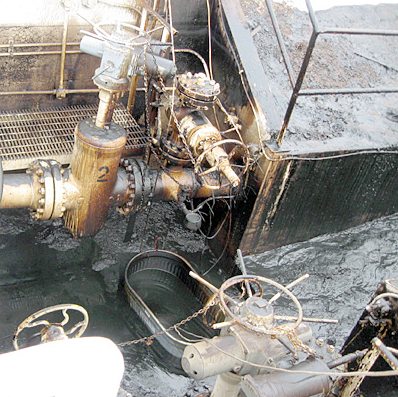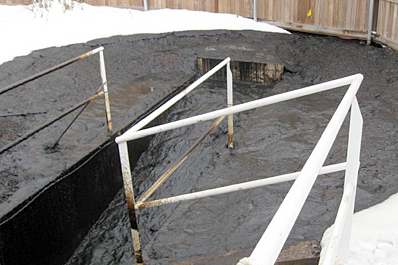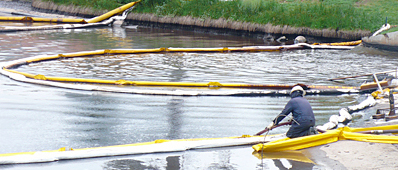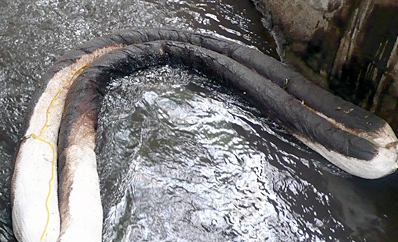2012
Red Butte Creek Oil Spill Final Closure Document
- News Release
- Close of Comments: December 10, 2012
- Public Hearing: Open House on Wednesday, November 28, 2012 at Pingree School Gymnasium, 780 S. Guardsman Way, Salt Lake City, 5:30-7:30 p.m.
- Contact (Email): Chris Bittner (cbittner@utah.gov)
- Type: General Water Quality
Chevron Pipeline Spills 2010
Oil Spill Updates
Update June 8, 2011: One Year Later
June 12, 2011 marks one year since the first Red Butte Creek Oil Spill. Phase 1 of the creek clean up was completed last summer and fall with crews working down the creek using washing/flushing equipment and various oil absorbing booms. Liberty Lake was cleaned up over the winter, pond sediment was fully removed and structures that were oil contaminated were either cleaned or replaced.
There is still residual oil in Red Butte Creek that can show up in backwater areas or in sediment and vegetation along the creek bank. Residents do report oil odors at times and still see evidence of oil residuals in the creek. DEQ has been committed to responding to all of these reports.
High runoff this spring has produced scouring flows in Red Butte Creek that should prove very beneficial in removing residual oil from the creek. Following runoff, DEQ will undertake further monitoring in Phase 2 of the cleanup for water quality, creek sediment, creek bank soil, and aquatic organisms to determine how the creek responds and what further clean up measures are needed.

Update December 6, 2010, 12:30 p.m.
Cleanup Continues, Water/Soil Tests to be Reviewed
The majority of the released crude oil has been removed and cleanup of residual contamination continues. However, the amount of oil spilled from a faulty pipeline valve turned out to be 500 barrels, up from the 200 barrels earlier reported.
On Friday, investigators from the U.S. Department of Transportation’s Pipeline and Hazardous Materials Safety Administration met with the Utah Department of Environmental Quality, the Salt Lake Valley Health Department, the Salt Lake City Fire Department, the City’s public utilities office, federal workforce safety officials, and U.S. Rep. Jim Matheson to discuss the investigation into why the pipeline breached once again. The recent break occurred about 100 yards away from the release in June that sent about 800 barrels of oil into Red Butte Creek.
The Division of Water Quality has been collecting water samples to verify that chemicals from the oil are not getting into the creek. Officials plan to look over the data Tuesday, December 7, to review and interpret the information. Soil samples will begin today.
A response team remains on alert to protect the creek and respond to any unforeseen events. The pipeline has been shut down and city officials are pressing federal regulators to keep the pipeline shut down until a thorough, independent review confirms that it is safe.
- Clean-up Continues at Site of Second Chevron Oil Spill
- Salt Lake City Mayor Meets with Federal Officials

Update December 2, 2010, 2:25 p.m.
A New Chevron Oil Spill

Up to 200 barrels of crude oil spilled from an underground pipeline near Red Butte arden late Wednesday night, December 1. Chevron crews shut down the pipeline around midnight and quickly contained the leak to prevent it from entering Red Butte Creek.
The Division of Water Quality immediately began sampling at several locations in the creek near the spill location to determine if any oil product has or is entering the water. Chevron officials identified the spill as a condensate mix, which is a byproduct of crude oil with traces of hydrocarbons. A backhoe and vacuum trucks are on site and a 75-foot berm is around the creek to protect it. Chevron officials say the cause of the spill was a break in a valve box south of where the spill occurred in June.
- Aerial Photograph (12/02/10)
- Chevron Oil Spill SLC Media Advisory
Update June 22, 2010, 5:00 p.m.
Water Tests Indicate Some Threat to Aquatic Life; Spill Contained Largely in Red Butte Creek
Salt Lake City, Utah—More comprehensive water tests analyzed over the last few days show the oil spill was largely contained in Red Butte Creek and did not spread significantly into the Jordan River or the Great Salt Lake.
“This is good news,” said Walt Baker, director of the Division of Water Quality (DWQ). “It appears from analyzing the data that even though some of the oil made it to the Jordan River, the concentrations are low enough that we aren’t seeing any real threats to aquatic life.”
DWQ scientists collected water samples at 14 locations, from the origin of the spill at Red Butte Creek to the shores of the Great Salt Lake, analyzing the most toxic components of the oil to determine its effects on aquatic life.
“Among the upper sites where the presence of petroleum products is still evident, the combined effect of all pollutants indicates both acute and chronic toxicity to aquatic life. However, this toxicity has decreased more than three-fold since the initial sample results. Even so, the long-term impact of the petroleum discharge is yet unknown,” Baker said.
DWQ will continue to monitor the sites during the cleanup phase while long-term monitoring plans for soils and sediments are being developed.
Update June 21, 2010, 2:42 p.m.
Unified Command Outlines Recovery Plan, Pipeline Starts Up
- Round-the-clock efforts to recover residual oil from the Red Butte Creek spill continue.
- Chevron, federal, State and local agencies have evaluated areas affected by the oil spill and are designing cleanup and recovery strategies specific to the different locations.
- Once the draft Cleanup/Recovery Plan is developed by Unified Command it will be made available to the public.
- The draft Cleanup/Recovery Plan will consider short-term and long-term objectives, including issues such as access to public areas, safety, and aesthetics.
- Chevron established a Website (http://www.redbuttecanyonspill.com) on June 19 to provide Salt Lake residents with the latest information on the spill response efforts.
- Crews have recovered approximately 610 barrels of the 800 barrels of oil spilled, with 100 barrels estimated to have evaporated.
Pipeline Start Up
- Normal pipeline operations resumed today, following a successful pressure test of a 13.75-mile section of pipeline on June 20.
- The startup plan was approved by the Unified Command in concurrence with the Department of Transportation.
- Trained personnel are monitoring the pipeline with ground and aerial observations.
Update June 21, 2010, 1:20 p.m.
Hole Size Revised
Preliminary information indicated that the hole that allowed the oil to leak from the pipeline was “about the size of a quarter.” That statement has been revised to indicate that the hole created by an electrical arc was one-half inch in diameter.
Update June 20, 2010
Oil Recovery Efforts Continue, Pipeline Test Successful
- Round the clock efforts to recover residue oil from the Red Butte Creek spill continue following a flush of the spill location.
- Water was released from the Red Butte Reservoir to increase the creek’s flow rate and water level at 3:00 pm on June 19 for approximately 90 minutes.
- Crews have recovered approximately 600 barrels of the 800 barrels of oil spilled, with 100 barrels estimated to have evaporated.
- Increasing the creek’s flow rate and water level assisted in mobilizing residue oil currently on the banks of the creek and in the culverts downstream to be captured by the booms, and collected by vacuum trucks and absorbent materials.
- Air monitoring of the site continues to be conducted.
Pipeline Test and Start Up
- Chevron successfully concluded a pressure test of a 13.75-mile section of pipeline on June 20.
- The pressure test and start up plan was approved by the Unified Command in concurrence with the Department of Transportation.
- As an additional safety factor the pipe was pressurized to 300 psi, well above the 60 psi of normal operating pressure.
- Following the pressure test, pipeline operations will resume June 21.
- Trained personnel are monitoring the pipeline with ground and aerial observations.
Update June 20, 2010, 4:08 p.m.
Oil Spill Clean-up Crews Discover Body
Work crews, cleaning up the oil spill along the creek at the mouth of Red Butte Creek made a gruesome discovery Sunday—a body.
Salt Lake police responded to the call shortly before noon. Officers confirmed it was the body of a person. Sources tell ABC 4 News workers were scrubbing the thick, black oil from the banks of Red Butte Creek when they spotted the remains. Witnesses say the body was so badly decomposed they couldn’t determine whether it was that of a male or a female. That evidence may suggest the person died before June 11, the night of the oil spill and was not related to the event.
Salt Lake police cordoned off the scene where the body was found, on the north bank of the creek, as detectives investigated to try to determine the cause of the death and the identity of the person.
Update June 19, 2010
Unified Command Approves Test of Pipeline
Pipeline Pressure Test
Chevron, in conjunction with the Red Butte Creek Spill Unified Command, voluntarily agreed to an additional measure of safety and has begun testing 13.75-miles of pipeline today to confirm it is safe to return to operation. The test will take place through Sunday night and will include filling the pipeline with water colored with environmentally-friendly dye. The pipe will be pressurized to 300 psi for four hours, exceeding the 60 psi of normal operating pressure. Trained personnel will monitor the pipeline for any leaks and be prepared to respond if any are detected. This monitoring will be done with ground and aerial observations.
The pipeline crosses City Creek, Red Butte Creek, and Emigration Creek. Citizens are asked to contact Chevron by phoning (866) 752-6340 or by Email (slcspill@chevron.com) if they see any greenish-yellow dye over the next two days.
Pipeline Startup
If the pressure test is successful, Chevron will resume normal pipeline operations. This process will include moving the pressure test dyed water through the pipeline to Chevron’s Salt Lake Refinery for recovery, treatment, and proper disposal. Startup of the pipeline should be completed after a successful pipeline pressure test.
The Unified Command has consulted with technical experts and concurs with the Department of Transportation, which regulates the pipeline operations, and has approved the filling and testing plan.
Note: Red Butte Creek Spill Unified Command is made up of the following organizations: Chevron, the United States Environmental Protection Agency, the Utah Department of Environmental Quality, Salt Lake County, Salt Lake Valley Health Department, and Salt Lake City.
Update June 17, 2010 4:30 p.m.
Additional Water Quality Tests Show No Immediate Threat
Salt Lake City, Utah—Additional test results for petroleum based compounds in the water sampled along the Red Butte Creek oil spill, including sites on the Jordan River, are very similar to earlier results showing no immediate threat to human health and aquatic life. Since lab results take 2 to 5 days to complete, the results from more extensive daily testing since Tuesday won’t be available until early next week.
DWQ is coordinating with EPA, Chevron, and other agencies to conduct a full spectrum analysis of water collected at some 13 locations along or near Red Butte Creek and the Jordan River. Water samples are being split three ways for the respective agencies along with Chevron, and then processed at independent laboratories. The focus of sampling now is to determine the extent of contamination along impacted waterways with an eye towards developing clean up standards to return these waterways to pre-spill conditions.
“As we saw in earlier results, the additional data show the more volatile and toxic components have dissipated. We aren’t seeing anything acutely harmful to human health or aquatic life” said Walt Baker, director of Water Quality (DWQ). “Some of the analysis anticipated early next week should provide a more complete picture on the full spectrum of potentially harmful components that remain in the waters.”
Update June 15, 2010, 5:20 p.m.
Oil Spill Samples: First Water Quality Tests Show No Immediate Threat
Salt Lake City, Utah—Initial test results for petroleum-based compounds in the water sampled along the Red Butte Creek oil spill do not indicate an immediate threat to human health and aquatic life. However, more extensive testing is ongoing to determine the full extent of the contamination from other components of the oil and the longer-term effects on the environment.
“It appears the most toxic components sampled have dissipated and we aren’t seeing anything acutely harmful to human health or aquatic life based on the data we have so far,” said Walt Baker, director of Water Quality (DWQ). “We, however, continue to sample a more comprehensive number of contaminants to give us a better indication for harmful components that remain in the waters,” he added.
DWQ on Monday sent a dozen water quality samples to the Unified State Lab. Samples were taken at various locations along the length of Red Butte Creek, from the spill through Liberty Park, and where the water enters the Jordan River. Another set of samples at these and additional locations was taken late Monday to a commercial lab for testing. Results will be ready on Wednesday.
There are many potentially harmful elements in petroleum products. Future sampling will give us a more complete picture of impacts of the spill to the environment.
Update June 14, 2010, 8:00 a.m.
DEQ Assists with Oil Spill Clean Up
Results of Water Samples to be Unveiled at 7:00 Tonight at Clayton Middle School
At around 7:30 a.m. Saturday, June 12, a caller notified the Division of Environmental Response and Remediation that a Chevron pipeline had ruptured at Red Butte Gardens, sending an estimated 500 barrels of crude oil into the Creek and flowing into Liberty Park Lake. An incident command post was established with Salt Lake City response teams working with Chevron crews to clean it up.

The Division of Water Quality immediately sent out two crews to collect water quality samples along the length of Red Butte Creek, from the spill through Liberty Park, and where the water enters the Jordan River. Jim Harris is testing for toxic chemicals that could damage the millions of birds that visit the Great Salt Lake. The samples were taken to the State Lab at 6 a.m. Monday, June 14. Results will be available by the town hall meeting held at 7:00 tonight (June 14) at Clayton Middle School, 1470 South 1900 East.
“It’s looking like the product did not reach the Great Salt Lake,” said Walt Baker, director of Water Quality. “We continue to monitor the Jordan River with two crews. I’ve been told that there is no sheen visible at Burnham Dam, which is 12.5 miles north of mile post 0, which is at the confluence of the 1300 south outfall of one of the pipes leading from Liberty Park. The other enters the Jordan River at 900 South. It is at Burnham Dam that the Jordan River splits. The East Arm becomes the State Canal which feeds into the Wildlife Management Area (WLA) north of the Bountiful City landfill. There is an outfall from the WLA into Farmington Bay. The West arm feeds into the impounded wetlands of the duck clubs.” There is a visible sheen at 1800 North (at the north end of the Rose Park Golf Course and approximately mile post 6 and a noticeable odor of volatile organic compounds (VOCs). “We will continue to monitor. The lab will open up at 6 a.m. monday morning and will be able to complete 12 VOC lab samples. We will have the results by the 7:00 p.m. public meeting at Clayton Hill Middle School.”
For Those Impacted: Property Damage or Hotel Reimbursements
Chevron has a number you can call to file claims: (866) 752-6340. In addition, the public may submit comments and concerns regarding the spill
- Salt Lake City Joint Information Center (801) 535-7171
- Email: oil@slcgov.com
- Online form
Update June 14, 2010, 12:30 p.m.
Chevron Revises Spill Estimate
Chevron officials are estimating that 33,000 gallons oil spilled from a quarter-sized hole in the pipeline that was caused by an electrical arc. At an 11:00 a.m. news conference, called by Mayor Ralph Becker, Chevron refinery manager Mark Sullivan said the investigation into the incident is ongoing but he suspects an electrical arc from a nearby high voltage power line cut the hole in the pipe.
Update June 13, 2010, 7:30 p.m.
Salt Lake City Issued the Following Media Advisory
Salt Lake City response teams are continuing to work with Chevron crews on the Red Butte Creek oil spill. The Environmental Protection Agency (EPA) is onsite to observe progress and has brought in a water recovery expert from the National Coast Guard. Pipeline emergency response teams continue to arrive in Salt Lake City to continue to contain the oil, minimize the impact of the incident on the community and the environment, and finalize a cleanup plan.
By nightfall yesterday, the leak was effectively stopped at Red Butte Creek. However, wildlife assistance and treatment, shoreline residue and riverbed damage continue to be the focus of clean-up efforts. Absorbent booms at the outlets of two culverts and other locations along the Jordan River are being deployed by Chevron response teams to contain the leak and minimize migration of the oil into the Great Salt Lake.

The Salt Lake Valley Health Department and the State of Utah are conducting ongoing sampling on the Jordan River to investigate water quality and the extent of the oil downstream toward the Great Salt Lake. There is no impact on municipal drinking water as the affected waterways are not part of Salt Lake City’s water supply. Although the City does not expect any contamination issues with its water sources, it will be regularly monitoring ground and well water.
Residents should not attempt their own cleaning efforts as crude oil is hazardous in nature. Chevron continues to take complaints and receive claims at a 24-hour claims hotline (866-752-6340).
“Speaking with neighbors affected by this spill, and seeing the environmental and wildlife impacts, I am saddened about the extent of the damages and will do all I can to ensure our City’s natural assets are restored,” said Salt Lake City Mayor Ralph Becker. “After speaking with Chevron Pipeline President Becky Roberts last night, and working with the teams Chevron has deployed here in Salt Lake City, I am confident in our ability to effectively work with Chevron to see that Salt Lake City recovers from this disaster.”
“We regret this problem that has caused the challenges now facing the community. Chevron takes full responsibility for addressing the situation,” said Sean Comey, Chevron Corporation’s Policy, Government, and Public Affairs media advisor. “We wish to thank everyone who assisted us in stopping the spill, containing its impact, and saving wildlife.”
A leak in Chevron’s pipeline, which brings crude oil in from western Colorado and eastern Utah into Salt Lake City, was discovered early Saturday morning. The full damage of the spill, which runs through the environmentally sensitive riparian corridor from Red Butte Creek to the Jordan River, has yet to be determined. The total amount of crude oil leaked into Salt Lake City’s waterways is currently being assessed, as is an estimate of the financial scope of the damages.
Hogle Zoo effectively treated and cleaned nearly 200 waterfowl and is holding them for observation. Additional birds have been taken by City teams to be cleaned at an offsite location.
Community outreach efforts continue as City representatives, volunteers, and Chevron teams go door-to-door in affected neighborhoods providing information and answering questions related to the spill.
A Town Hall meeting will be held at Clayton Middle School, 1470 South 1900 East, on Monday, June 14 at 7:00 pm. City and Chevron representatives will be available to address questions and concerns, and share the most recent information on the spill.

Updates Documents
Documents Jump to:
- Chevron request for cessation of monitoring and
Red Butte Creek Risk Characterization Report: Data Summary and Comparison to the 2011 Human Health Risk Assessment (HHRA) and 2012 Screening Level Ecological Risk Assessment (SLERA),
Appendices and
data spreadsheets (6/24/2016) - News Release: EPA requires Chevron Pipe Line to provide funding for oil spill response
- News Release: Red Butte Creek Chevron Oil Spill; Final Closure Documents Signed
- Final Signed Decision Document
- Final Signed Compliance Order
- Red Butte Creek Decision Document Public Comments and Responses
- News Release: Public Comment Period Runs Nov. 9-Dec. 10 Red Butte Creek Oil Spill Final Closure Document (Posted: 11/8/12)
- Red Butte Creek Oil Spill Final Closure Document-Draft for Public Comment
- Stipulated Compliance Order between Chevron Pipe Line Company and DWQ
- Final Human Health Risk Assessment
- Comments and Responses on Human Health Risk Assessment and Ecological Risk Assessment ofr Red Butte Creek, Salt Lake City, Utah
- Final Ecological Risk Assessment
- Ecological Risk Assessment Appendices
- Ecological Risk Assessment Appendix G
- Comments and Responses on Human Health Risk Assessment and Ecological Risk Assessment ofr Red Butte Creek, Salt Lake City, Utah
- News Release Health Risk Studies of Red Butte Oil Spill Available for Public Review Until 08/13/2012 (Posted: 7/12/12)
- Water and Sediment Data
- Human Health Risk Assessment
- Ecological Risk Assessment (RBC SLERA)
- Ecological Risk Assessment Appendices
- CPL’s Response to DWQ Review Comments, NOV Docket No. 110-01 (38.5 MB) (Posted: 04/03/12)
- Red Butte Creek Mitigation Funds: Awarded Funding (Posted: 02/08/2012)
- News Release: Chevron Penalty Money to Fund Water Project—Red Butte Creek Mitigation Projects Selected (Posted: 02/08/12)
- Water, Sediment, and Macroinvertebrate Sampling Results and Summaries (Posted: 03/13/12)
General Information
- Press Release November 14, 2011: Red Butte Creek Water Settlement Finalized
- Final Settlement Agreement
- Public Comment Letters
- B. Randall Comments
- Great Salt Lakekeeper Comments
- Agency Response to Comments
- Public Comment Letters
- Request for Proposals Announcements and Application Form
- Word Editable Version
- Public Health Assessment
- Email Address For Public Input (RedButteOilSpill-input@utah.gov) Send DEQ feedback or report oil found in Red Butte Creek, or phone (801) 313-6700, 8:00 a.m. to 5:00 p.m. workdays to speak with someone from the Salt Lake Valley Health Department.
Chevron Notice of Violation Response
Chevron Notice of Violation Response Letter
- Appendix A: Site Characterization Summary and Remediation Plan
- Appendix A: Continued
- Appendix B: Removal Action Workplan
- Appendix C: Red Butte Creek Stormwater Culvert Inspection Plan
- Appendix D: Salt Lake City Red Butte Creek Incident Water and Sediment Sampling Plan
- Appendix E: Wildlife Management Plan
Attachments
- Attachment A: Supporting Calculations for the Estimated Quantity of Oil Released
- Attachment B: Waste Management Documents
- Attachment C: Maps
- Attachment D: Environmental Monitoring Plan
- Attachment E: Draft Long-term Cleanup Plan
Prior Updates
Water Quality Data
- Chemical Data Summary (08/26/10)
- Explanation of Variables (08/26/10)
- Monitoring Maps and Locations
- Red Butte Oil Spill Chemical Data Summary (11/30/2010)
Spill Related Documents
- Chevron Pipeline Block Valve Release: Response to Notice of Violation and Order Docket No. I10-05 (03/17/11)
- Draft Clean-Up and Recovery Table (07/12/10)
- DWQ Notice of Violation: Spill 2 to Chevron for December, 2010 Spill
- Chevron Response (1/25/11)
- U.S. Department of Transportation Issues Corrective Order to Chevron (12/09/10)
- Water Board Notice of Violation: Spill 1 (07/15/10)
Liberty Lake
- Human Health Risk Assessment (05/10/11)
- Liberty Lake Cleanup Activities Completed: Grand re-opening slated for Celebrate the City event on May 14 (05/17/11)
- Liberty Lake Final Lab (04/27/11)
- Liberty Park Lake Human Risk Assessment (07/01/11)
- Liberty Park Lake Human Health Risk Assessment (08/04/11)
- Sample Location Map (06/06/11)
Health Information
- Health Effects of Oil Exposure
- Risk-based Health Screening Levels in Support of Sampling Activities at Red Butte Creek, Salt Lake City, Utah
- Screening Levels and Uncertainty Factors for Further Action
- Water Chemistry Explanation

